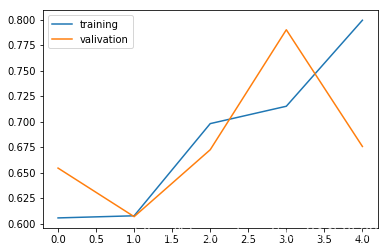版权声明:本文为博主原创文章,未经博主允许不得转载。 https://blog.csdn.net/qq_31456593/article/details/88930476
TensorFlow2教程-LSTM和GRU
Tensorflow 2.0 教程持续更新 :https://blog.csdn.net/qq_31456593/article/details/88606284
完整tensorflow2.0教程代码请看tensorflow2.0:中文教程tensorflow2_tutorials_chinese(欢迎star)
入门教程:
TensorFlow 2.0 教程- Keras 快速入门
TensorFlow 2.0 教程-keras 函数api
TensorFlow 2.0 教程-使用keras训练模型
TensorFlow 2.0 教程-用keras构建自己的网络层
TensorFlow 2.0 教程-keras模型保存和序列化
1.导入数据
num_words = 30000
maxlen = 200
(x_train, y_train), (x_test, y_test) = keras.datasets.imdb.load_data(num_words=num_words)
print(x_train.shape, ' ', y_train.shape)
print(x_test.shape, ' ', y_test.shape)
x_train = keras.preprocessing.sequence.pad_sequences(x_train, maxlen, padding='post')
x_test = keras.preprocessing.sequence.pad_sequences(x_test, maxlen, padding='post')
print(x_train.shape, ' ', y_train.shape)
print(x_test.shape, ' ', y_test.shape)
1.LSTM
def lstm_model():
model = keras.Sequential([
layers.Embedding(input_dim=30000, output_dim=32, input_length=maxlen),
layers.LSTM(32, return_sequences=True),
layers.LSTM(1, activation='sigmoid', return_sequences=False)
])
model.compile(optimizer=keras.optimizers.Adam(),
loss=keras.losses.BinaryCrossentropy(),
metrics=['accuracy'])
return model
model = lstm_model()
model.summary()
Model: "sequential_2"
_________________________________________________________________
Layer (type) Output Shape Param #
=================================================================
embedding_2 (Embedding) (None, 200, 32) 960000
_________________________________________________________________
unified_lstm_4 (UnifiedLSTM) (None, 200, 32) 8320
_________________________________________________________________
unified_lstm_5 (UnifiedLSTM) (None, 1) 136
=================================================================
Total params: 968,456
Trainable params: 968,456
Non-trainable params: 0
_________________________________________________________________
%%time
history = model.fit(x_train, y_train, batch_size=64, epochs=5,validation_split=0.1)
Train on 22500 samples, validate on 2500 samples
Epoch 1/5
22500/22500 [==============================] - 100s 4ms/sample - loss: 0.6589 - accuracy: 0.6056 - val_loss: 0.6090 - val_accuracy: 0.6544
Epoch 2/5
22500/22500 [==============================] - 100s 4ms/sample - loss: 0.6418 - accuracy: 0.6076 - val_loss: 0.6356 - val_accuracy: 0.6068
Epoch 3/5
22500/22500 [==============================] - 100s 4ms/sample - loss: 0.5763 - accuracy: 0.6980 - val_loss: 0.5984 - val_accuracy: 0.6724
Epoch 4/5
22500/22500 [==============================] - 102s 5ms/sample - loss: 0.5749 - accuracy: 0.7150 - val_loss: 0.5044 - val_accuracy: 0.7900
Epoch 5/5
22500/22500 [==============================] - 102s 5ms/sample - loss: 0.4893 - accuracy: 0.7993 - val_loss: 0.7230 - val_accuracy: 0.6756
CPU times: user 14min 29s, sys: 42.5 s, total: 15min 12s
Wall time: 8min 24s
import matplotlib.pyplot as plt
plt.plot(history.history['accuracy'])
plt.plot(history.history['val_accuracy'])
plt.legend(['training', 'valivation'], loc='upper left')
plt.show()

3.GRU
def lstm_model():
model = keras.Sequential([
layers.Embedding(input_dim=30000, output_dim=32, input_length=maxlen),
layers.GRU(32, return_sequences=True),
layers.GRU(1, activation='sigmoid', return_sequences=False)
])
model.compile(optimizer=keras.optimizers.Adam(),
loss=keras.losses.BinaryCrossentropy(),
metrics=['accuracy'])
return model
model = lstm_model()
model.summary()
Model: "sequential_3"
_________________________________________________________________
Layer (type) Output Shape Param #
=================================================================
embedding_3 (Embedding) (None, 200, 32) 960000
_________________________________________________________________
unified_gru (UnifiedGRU) (None, 200, 32) 6336
_________________________________________________________________
unified_gru_1 (UnifiedGRU) (None, 1) 105
=================================================================
Total params: 966,441
Trainable params: 966,441
Non-trainable params: 0
_________________________________________________________________
%%time
history = model.fit(x_train, y_train, batch_size=64, epochs=5,validation_split=0.1)
Train on 22500 samples, validate on 2500 samples
Epoch 1/5
22500/22500 [==============================] - 94s 4ms/sample - loss: 0.6498 - accuracy: 0.5847 - val_loss: 0.4840 - val_accuracy: 0.7664
Epoch 2/5
22500/22500 [==============================] - 98s 4ms/sample - loss: 0.4172 - accuracy: 0.8255 - val_loss: 0.4279 - val_accuracy: 0.8300
Epoch 3/5
22500/22500 [==============================] - 101s 5ms/sample - loss: 0.3179 - accuracy: 0.8825 - val_loss: 0.3918 - val_accuracy: 0.8472
Epoch 4/5
22500/22500 [==============================] - 99s 4ms/sample - loss: 0.3306 - accuracy: 0.8870 - val_loss: 0.3959 - val_accuracy: 0.8468
Epoch 5/5
22500/22500 [==============================] - 96s 4ms/sample - loss: 0.2607 - accuracy: 0.9120 - val_loss: 0.3849 - val_accuracy: 0.8532
CPU times: user 14min 25s, sys: 38.9 s, total: 15min 4s
Wall time: 8min 10s
plt.plot(history.history['accuracy'])
plt.plot(history.history['val_accuracy'])
plt.legend(['training', 'valivation'], loc='upper left')
plt.show()
